

Home > About Us > Service

1. Providing complete power solutions to our customers
2. Having elite engineering team, and strong production capacity
3. Constantly improving our producets and service quality
4. Being the first choice of the power industry
5. Being your professional and reliable partner

Our company has professional after-sales engineering team to ensure the various problems to be analysis rapidly, and our professional service team guarantee problems to be solved quickly.
Common Problem
We have professional engineers to help you design transformers according to your requirements.
目前我国公用电力路灯行业普遍使用的高压钠灯和低压钠灯,之所以选择使用钠灯是因为它们具备光效高、寿命长的特点。以高压钠灯为例说明:光效
120lm/w,平均寿命可以达到2年。但是它也具有自身的显著缺陷,那就是色温(K=1900/2200/2500)过低,显色指数(Ra=23 /60)太差。为了解决高压钠灯色温低,
光色严重偏红的问题,普遍采用的办法是提高功率,让功率达到250-400W用超多的光通量值来弥补物体偏色的问题。国家标准JT/T367--1997《公路照明技术条件
》要求的平均照度值大多数情况下在15LX,并不要求很高的光通量。这就是说,很多情况下,并不是需要使用如此大功率、如此高数值光通量的钠灯来照明,而是
因为光通量低的情况下,所有物体在灯下都会严重变色,普遍偏黄。
我公司生产的LED路灯作为新型光源,理论寿命高于5万小时,差不多可以使用10年时间,虽然它的光效低于钠灯,但它色温远高于钠灯,超高亮白光LED的色
温可以达到15000K,显色指数更是接近100,而且色温等具体数值还可以随需要调整,这就可以选择更适合人眼感觉适宜的范围制造大小不等的产品。在色温适宜的
条件下,LED作为光源的照明灯具虽然显示的照度稍低,但光色明亮,显色指数高。
目前,LED作为照明光源的核心部件还有一个独特优势,就是LED发光芯片属于固体发光器件,稳定性好,不受外界环境温度影响。相对于高低压钠灯或者金
卤灯、节能灯等气体发光光源更适合在北方环境温度较低、不同季节温度变化较大的自然环境下使用。
这就是说,同样达到国家标准的照明要求,使用LED光源就可以大幅降低照明器功率,同时也就可以大大降低耗电量,所以国家才会大力提倡广泛使用LED产
品。为了适应市场对LED 需求的快速增长, 我国已将LED 作为"31 项国家鼓励发展的电子产品"之一和"20 种鼓励外商投资的电子产品和技术"之一, 重点予以发展。
目前国内市场, LED作为照明光源也越来越显示出它独特的优势,已经在国内多个城市开始普及。
回答1
为了使POWER SUPPLY的寿命增长,建议选用多30%输出功率额定的机种。例如若系统需要一个100W的电源,则建议挑选大于130W输出功率额定的机种,以此类推可有效提升POWER SUPPLY的寿命。
此外尚需考虑POWER SUPPLY的工作环境温度,及有无额外的辅助散热设备,在过高的环温POWER SUPPLY需减额输出。环温对输出功率的减额曲线请参照产品规格书。
根据应用所需选择各项功能:
• 保护功能 : 过电压保护 (OVP) 、过温度保护 (OTP) 、过负载保护 (OLP) 等。
• 应用功能 : 信号功能 (POWER GOOD 、 POWER FAIL) 、遥控功能、遥测功能、 并联功能等。
• 特殊功能 : 功因矫正 (PFC) 、不断电 (UPS)。
4.选择所需符合的安规及电磁兼容 (EMC) 认证。
A: You can contact us at any time. Our engineers are ready to provide you with technical support or suggestions.
1. the current density is lower;
2. reduce the number of turns, but will increase the core flux density increased when using iron loss, copper loss was significantly higher than that of iron loss, caution;
3. change the process to reduce the transformer winding AC resistance. Methods mainly reduced wire diameter (can not reduce the total cross-sectional area), increase primary level adjacent surface (primary and secondary distribution capacitance will increase, decrease the initial level (distance) will increase the primary and secondary distribution capacitance), sparse coil Rao etc.;
4. change the circuit parameters to reduce the AC resistance, such as reducing the switching frequency, but increases the core flux density increased when using iron loss, copper loss was significantly higher than that of iron loss, caution;
Wire 5, use lower resistivity.
Iron loss reduction
1. use power parameters more excellent core materials, such as the use of TDK PC50 material instead of PC40 material;
2. magnetic flux density is reduced, but it will increase the number of turns of the coil and the resulting copper loss increases with caution;
3. the change of circuit parameters, such as reducing the switching frequency, but will also increase the magnetic flux density, with caution, when necessary to adjust the number of windings;
4. reasonable thermal design, the core material temperature and loss curve in the valley;
Comprehensive method
1. according to their respective cooling conditions, reasonable distribution of copper loss loss ratio;
2. reasonable design of the core flux density and frequency, the core work in the FB optimal combination of state.
Similarities: They are all wrapped with enameled wire, with iron core or magnetic core inside.
Differences: Transformers are mainly used for voltage conversion, based on the law of electromagnetic induction. Inductance coils are generally used in electronic circuits, according to Lenz's law. The former usually has two or three windings, including primary winding and secondary winding. For boost transformer, the primary winding turns are few, the secondary winding turns are many and the line diameter is thin. On the contrary, step-down transformer has many primary windings, and the secondary winding turns are few and the line diameter is thick. It is widely used as power supply in various electrical appliances. Inductance coils are basically used in two aspects in electronic circuits:
1. It is used in waveform generation circuit or frequency selection circuit in conjunction with capacitor resistance.
2. It is used as a smoother in series circuit when the current is large and the pulsation is large. There are many other occasions, such as the ballast in fluorescent lamp, which is mainly based on the principle that the current at both ends of inductance coil can not change abruptly, and the high reverse electromotive force can be generated when the current change rate is too fast.
The filter inductor is usually made of ferrite material. It can be easily combined with the through-core capacitor to form a composite filter. In high performance filters, the winding inductor is also used. However, it should be noted that magnetic saturation occurs in ferrite materials at high current, which reduces the efficiency of the filter.
Output filter inductance is a key element in full bridge inverter. The grid-connected system requires that the power factor of the output side of the inverter is 1, the waveform is sinusoidal, and the output current is the same frequency as the grid voltage. Therefore, the selection of inductance directly affects the performance of the circuit.
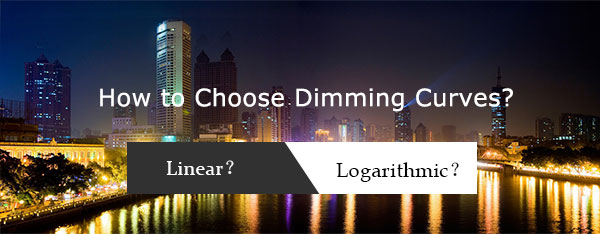 |
Often, the LED lighting system consists of a (wall) dimmer or controller, a driver and a luminaire. To dim the light, you move the slider or turn the wheel and the dimmer sends a signal to the driver. The driver translates that signal to an electrical current that powers the LED.
 |
In linear dimming curves of LED drivers, the brightness output is linear in relation to the digital signal value which is translated by the driver. For instance, if the digital signal value is at 25%, the brightness output is at 25%- see A.
However, in logarithmic dimming curves, the digital signal value changes slower at deeper dimming levels and faster at the brighter end-see figure B.
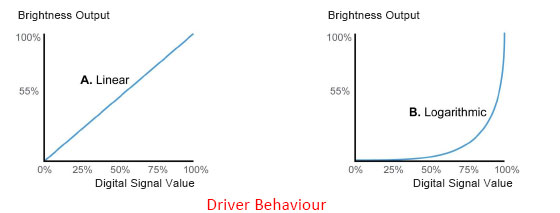 |
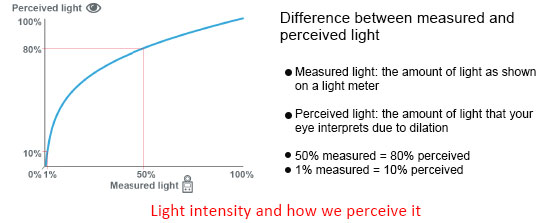 |
If the system is not configured properly, the dimming performance can be unsatisfactory. In figure 4, the difference in light output is quite large. And at the bright end on the right, the difference is barely noticeable. The whole dimming effect is not good.
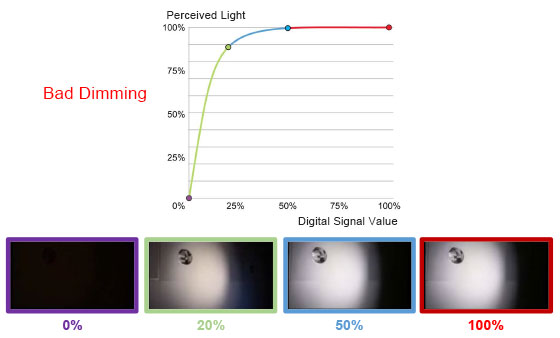 |
The light level changes evenly with the dimmer position. The result of a much better implementation of a lighting system is shown in figure 5.
 |
To achieve perfect dimming performance, the brightness of the LED must be matched to the way our eyes behave. With a linear dimmer, a logarithmic dimming curve should be used in the driver.
 |
From LEDinside
This content was originally published on the OSRAM Digital Systems blog. You can read the original blog post here.
The term ‘Internet of Things’ is a growing topic of conversation. What exactly is the Internet of Things (IoT) and what does smart lighting have to do with it?
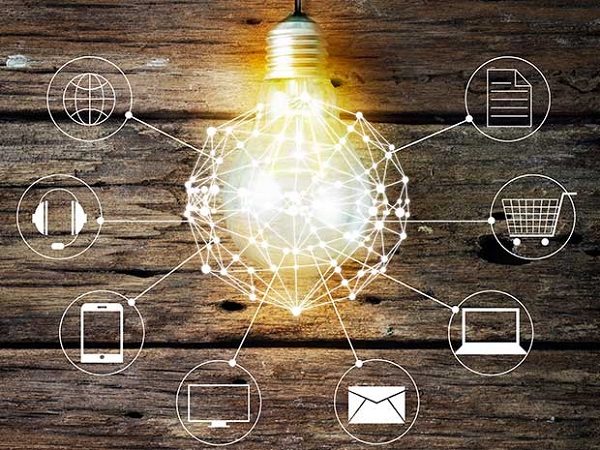 |
How is the IoT Different from the Traditional Internet?
The internet is a worldwide system of computer networks that until now, has been about giving people access to information upon request. We do a search in Google or another search engine to find information, or send a request to a specific site to consume content of interest. The content posted to the web is created by humans, for humans. We have a question. We get an answer. When we want to connect with someone or share something with them, we go to LinkedIn or Facebook or another social media platform. The traditional internet has become so ubiquitous and so transformative that it is a digital fabric woven into our everyday lives.
With the IoT, content is in the form of data that is generated by a device or a machine (i.e., a ‘thing’). The transfer of data is primarily between ‘things’ with embedded sensors and a central system that collects and organizes the data from those sensors. Content is typically pushed out as a notification that something of interest has happened, and this then triggers an action on the part of another ‘thing’, group of ‘things’ or a process tied to ‘things’ connected on the network.
What is the value of the IoT? Timely communication of data when it is detected. Timely actions based on that data. Enhanced efficiencies of systems and processes that benefit humans, the spaces we live and work in, the environment, and more.
Emerging applications, some of which haven’t been dreamed of yet, will make the IoT ubiquitous and so transformative that it will become a newer version of the digital fabric that is woven into our everyday lives.
IoT is Already Here
From a consumer perspective, many of us already have a wearable such as a smartwatch that tracks our activity level and enables smartphone applications like text messages and phone calls. Many of us have installed a smart home device such as the Nest Thermostat that learns the temperatures we like and adjusts it automatically to our family’s schedule while also enabling us to control it from our smartphone from anywhere if necessary.
Both use embedded sensors to detect a change in the wearer or environment (respectively) and both take action based on the data received (they notify us to slow down our heart rate or notify the system to increase the temperature). Both are data-driven, internet-connected devices with embedded sensors, and both have a user-friendly interface. There’s a value-add for each too. The smartwatch indirectly encourages us to stay active and healthy and gives us insight into our health. The Nest helps us stay comfortable while also reducing our energy usage and related bills.
Commercial Real Estate Applications
In commercial real estate (CRE), Passive InfraRed (PIR) sensors detect motion that identifies whether space is occupied or unoccupied. Sensor data is transferred to a central system that collects and organizes data from the space, and then notifications can be sent to the lighting system to turn the lights in the area ‘on’ (if someone has walked into the space) or ‘off’ (when the space is unoccupied). Data notifications can also be sent to the HVAC system to take the action of reducing or increasing the heating or cooling of that space.
Although saving energy and related costs have been the driver behind most smart building applications such as connected lighting, IoT is enabling applications with more benefits. According to Deloitte, “…the Internet of Things (IoT) is already having a significant impact on the Commercial Real Estate (CRE) industry, helping companies move beyond a focus on cost reduction. IoT applications aim to grow margins and enable features such as dramatically more efficient building operations, enhanced tenant relationships, and new revenue generation opportunities.” The data collected from ‘things’ with embedded sensors gives insight into tenant behavior as well as building usage.
Currently, we are at the infancy stage of what the IoT will enable—today we are seeing just a sliver’s worth of applications from a very big pie of potential applications. According to analyst firm Gartner, more than 20 billion devices are expected to be connected to the internet by 2020.
In fact, the IoT has been coined ‘the next industrial revolution’ with emerging applications anticipated and many individuals and organizations looking to stay ahead of the curve. Industry leaders are adopting technologies and infrastructures they believe will support future applications.
Smart Lighting and IoT
Smart lighting is playing a pivotal role, unlocking the power of the IoT and smart building applications. Lighting is ubiquitous throughout all buildings and every luminaire is connected to a source of power. It is the perfect conduit for collecting data on what is happening in the building at any given time. Sensors are embedded in the luminaire making each light point a data node on the network.
What is driving adoption of smart lighting systems?
1. Energy and operational savings - According to IBM, the day-to-day operation of a building represents over 70% of the total cost of that building over its lifespan. The immediate impact of IoT in commercial buildings is to lower operations costs, particularly in the form of energy savings.
2. Building Efficiencies – By creating a digital version of a building and its internal operations including systems (lighting, HVAC, security, etc.) and occupant activities, you can visualize what is actually happening in the building, and use those insights to make better decisions. The granularity of data within a lighting system from different sensors can be analyzed to create a detailed picture of a space. These new insights enable facility executives to centrally manage systems in the building or group of buildings while improving efficiencies.
3. Occupant Health and Well-Being – According to Navigant Research, “In recent years, there has been a growing shift toward occupant health and well-being as a driver in commercial buildings. Lighting has been a leader of building technologies within this overarching goal, allowing for increased controllability. Within commercial offices for example, the increased controllability through an IoT lighting system, can help occupants improve productivity, and stay awake and more focused on tasks.”
